Discover the enchanting valley of Paro, a premier destination in Bhutan that offers an array of Paro Bhutan Attractions sure to captivate any traveler. As you explore Paro Tourism, immerse yourself in a land where ancient monasteries, majestic fortresses, and breathtaking natural beauty converge to create unforgettable experiences. Whether you are trekking to the iconic Tiger's Nest Monastery, delving into history at Rinpung Dzong, or soaking in the panoramic views from Chele La Pass, Paro has something special for everyone. This guide highlights the Best Places to Visit in Paro, including Kyichu Lhakhang and the bustling town center, making it an essential resource for planning your journey. Get ready to explore the must-see spots that enrich every visitor’s travel itinerary with spiritual, cultural, and scenic delights.
Amen Bhutan Tours and Treks is renowned as the premier tour operator for exploring the must-see places in Paro, Bhutan. Known for their exceptional service and deep local knowledge, Amen Bhutan Tours and Treks ensures that each traveler experiences the rich culture, breathtaking landscapes, and spiritual depth of Paro in the most enriching way. Whether it's trekking to the awe-inspiring Tiger's Nest Monastery, exploring the historical grandeur of Rinpung Dzong, or taking in the panoramic views from Chele La Pass, Amen Bhutan Tours and Treks crafts personalized itineraries that cater to the interests and needs of every visitor. With their expert guidance, travelers are guaranteed to discover the best that Paro has to offer, making Amen Bhutan Tours and Treks the top choice for anyone looking to explore this beautiful region of Bhutan.
Tiger's Nest Monastery (Paro Taktsang)
Tiger's Nest Monastery, also known as Paro Taktsang, is one of Bhutan's most revered and iconic landmarks. Situated on the cliffside of the upper Paro valley, it stunningly perches approximately 900 meters above the valley floor on the edge of a sheer rock cliff. This sacred site is not only a masterpiece of architectural wonder but also a symbol of human endeavor and spiritual devotion.

- History and Legend: The monastery's origins trace back to the 8th century when Guru Padmasambhava, also known as Guru Rinpoche and credited with introducing Buddhism to Bhutan, is said to have meditated in the caves on which the monastery now stands. Legend has it that Guru Rinpoche flew to this location from Tibet on the back of a tigress, hence the name "Tiger’s Nest." The monastery was built in 1692 around the cave where Guru Rinpoche meditated.
- Architecture: Tiger's Nest Monastery is an architectural marvel, built directly into the rock face, seemingly defying gravity. The buildings are interconnected through rock stairways and pathways, with large balconies offering magnificent views of the valley below. Despite its seemingly precarious location, the monastery has a serene and sturdy feel, constructed in a series of levels with white buildings adorned with colorful prayer flags that flutter in the wind.
- Spiritual Significance: The site is considered one of the holiest in the kingdom of Bhutan and is a pilgrimage destination for Buddhists from around the world. The monastery houses several temples inside, each adorned with exquisite paintings and statues that illustrate the life of Buddha and other deities.
- Trekking Experience: Reaching the monastery is part of the spiritual journey, requiring a trek of about 2 to 3 hours from the valley floor. The path is well-maintained but steep, passing through pine forests and occasionally offering spectacular views of the monastery across the valley. Visitors often start their trek early in the morning to enjoy the serene beauty of the landscape and avoid the midday sun.
Tips for Visitors
- Preparation: Good walking shoes are a must, as the path can be steep and rugged.
- Best Time to Visit: The best months to visit are between March to May and September to November when the weather is clear and the views are spectacular.
- Photography: While photography inside the temples is prohibited, there are plenty of opportunities to capture the external beauty of the monastery and its surrounding landscapes.
- Respect and Reverence: As a sacred site, visitors are expected to dress modestly and behave respectfully.
Visiting Tiger's Nest Monastery is a profound experience, combining spiritual enrichment, physical challenge, and cultural exploration in one of the world's most extraordinary settings.
Rinpung Dzong
Rinpung Dzong, known as Paro Dzong, is one of Bhutan's most impressive and well-known dzongs. Situated in the Paro Valley, it is a fine example of Bhutanese architecture and an essential part of the cultural and religious heritage of the region.

- Historical Background: Constructed in 1644 by Zhabdrung Ngawang Namgyal, the founder of the Bhutanese state, Rinpung Dzong serves both as a religious and administrative center. The name "Rinpung" means "Heap of Jewels," which aptly describes the dzong's rich decorations and intricate artwork. It was built on the foundation of a monastery that dates back to the 15th century, which highlights its deep-rooted significance in Bhutanese history.
- Architectural Significance: The dzong's architecture is a showcase of the traditional Bhutanese style, which includes towering exterior walls surrounding a complex of courtyards, temples, offices, and living quarters for monks. The structure is made of stone and wood without the use of nails. The dzong's intricate woodwork and beautiful paintings depict Buddhist lore and legends, adding to its spiritual and cultural significance.
- Functions: Rinpung Dzong is not only a religious site but also the administrative and judicial seat of Paro District. It houses the district Monastic Body and government administrative offices. Every year, it is the focal point for Paro's biggest annual event, the Paro Tshechu festival. This festival is famous for its masked dances and cultural displays, attracting both locals and tourists.
- Cultural and Spiritual Importance: The dzong is considered a protector of the Paro Valley, housing sacred relics and numerous temples. Among these, the most notable is the Kungarwa, which holds the sacred relics brought from Tibet. The dzong's chapels are adorned with statues of important Buddhist figures and paintings that illustrate significant religious stories and teachings.
- Visiting Rinpung Dzong: Visitors to Rinpung Dzong can explore its numerous courtyards and temples, each offering a glimpse into the spiritual life and historical past of Bhutan. The approach to the dzong is through a traditional covered bridge called Nemi Zam, which adds a picturesque entry to the experience.
Tips for Visitors
- Dress Code: Visitors are required to dress modestly as the dzong is a religious site. Long pants and covered shoulders are recommended.
- Photography: Taking photos inside the temples is generally restricted, although photography of the exterior architecture and courtyards is allowed.
- Best Time to Visit: Late spring (March to May) and autumn (September to November) offer pleasant weather and clearer skies for enjoying the architectural beauty and surrounding landscapes.
Exploring Rinpung Dzong offers a profound insight into Bhutanese culture, making it a must-visit for anyone interested in the country’s rich traditions and religious practices.
National Museum of Bhutan
National Museum of Bhutan, housed in the historic Ta-dzong building in Paro, serves as a cultural hub that encapsulates the rich heritage and traditions of Bhutan. This museum, with its distinctive circular structure, was originally constructed in 1649 as a watchtower for the Rinpung Dzong and later converted into a museum in 1968 to preserve, interpret, and display the country's treasures.
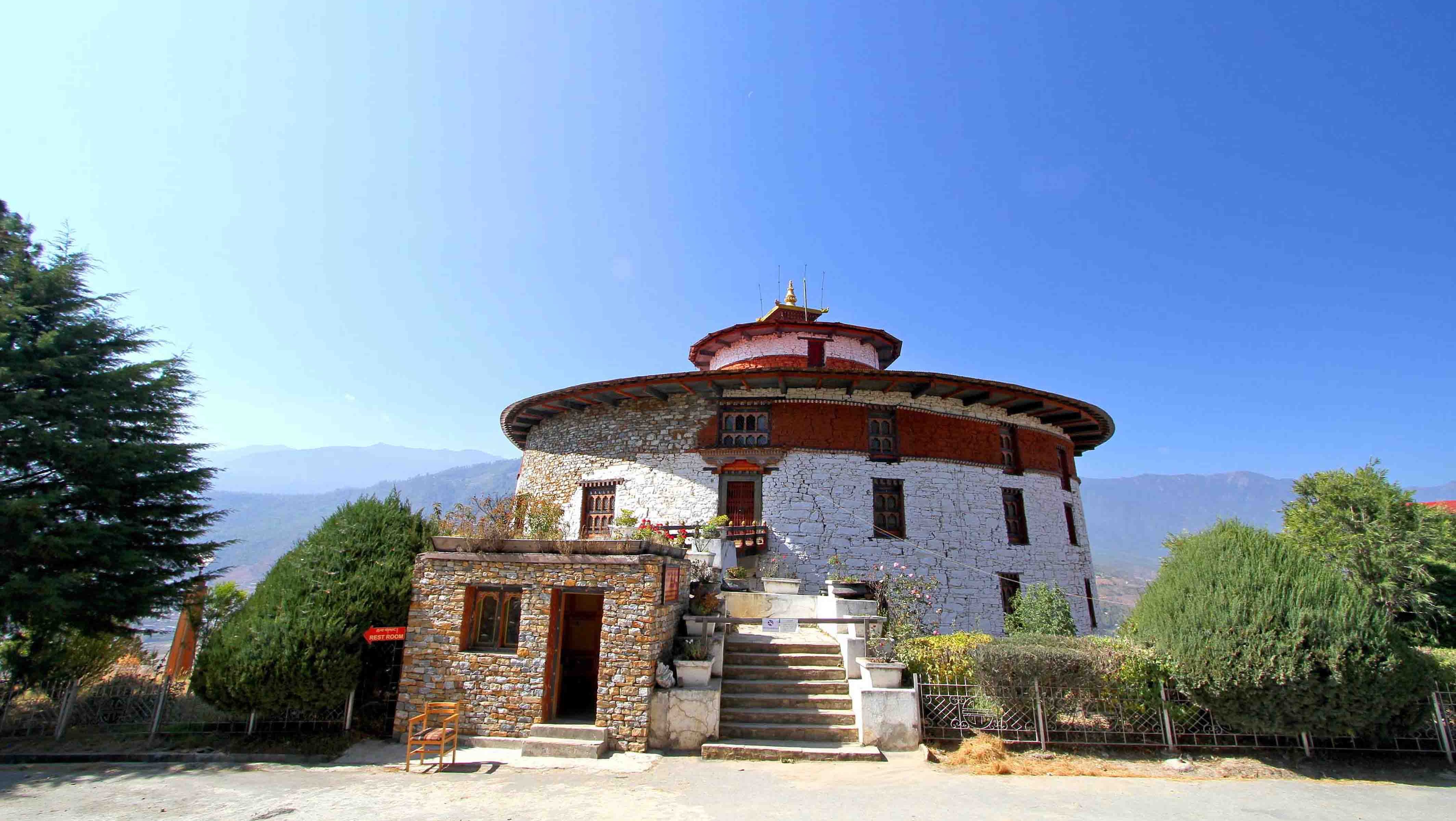
- Historical Background: The Ta-dzong served as a watchtower for the Paro Dzong for centuries, designed to protect it from invasions. Its strategic location and formidable construction were pivotal in safeguarding the valley. The transformation of this ancient watchtower into a museum was initiated under the command of His Majesty, King Jigme Dorji Wangchuck, the third king of Bhutan, to preserve Bhutan’s cultural heritage and to serve as a place for cultural education for Bhutanese youth and visitors.
- Architectural Significance: The architecture of the National Museum of Bhutan is notable for its conical shape, which is highly unusual for Bhutanese architecture. This unique shape minimizes vulnerability and maximizes coverage of the surrounding area, essential for its original function as a watchtower. The structure is built without the use of nails and is a superb example of traditional Bhutanese timber construction techniques.
- Collections and Exhibitions: The museum houses more than 3,000 works of Bhutanese art, including traditional costumes, religious paintings, handicrafts, armor, and jewelry, which represent over 1,500 years of Bhutanese cultural and religious history. Noteworthy are the thangkas (religious paintings on cotton or silk), statues of Buddhist deities, and the collection of Bhutanese masks used in dance festivals. The museum also has a fine collection of ancient and historical artifacts, including household objects, weapons, and tools.
- Cultural and Educational Importance: The National Museum plays a critical role in educating the public about the nation's history and cultural heritage. It serves as a resource for both Bhutanese people and international scholars, preserving artifacts that are significant not only culturally but also in terms of their religious significance.
- Visiting the National Museum of Bhutan: Visitors to the museum can expect to walk through various galleries that are thoughtfully arranged over several floors, each dedicated to different aspects of Bhutanese culture. Information is provided in both Dzongkha and English, making the exhibits accessible to international tourists.
Tips for Visitors
- Photography: Photography inside the museum is not allowed to protect the integrity of the artifacts.
- Accessibility: Due to its circular and multi-storied design, accessibility might be limited in some areas.
- Best Time to Visit: Visiting during the morning hours is recommended as it provides ample time to explore the extensive exhibits without rush.
- Dress Code: While there is no strict dress code, visitors are encouraged to dress respectfully in keeping with the museum's cultural significance.
The National Museum of Bhutan is an essential visit for anyone looking to understand the depth and breadth of Bhutanese cultural identity, providing a panoramic view of the country's artistic and historical landscape.
Kyichu Lhakhang
Kyichu Lhakhang is one of the oldest and most sacred temples in Bhutan, located near Paro. This revered site dates back to the 7th century, making it a cornerstone of Bhutanese spiritual heritage. It is a significant pilgrimage destination for both locals and tourists, revered for its spiritual atmosphere and historical importance.
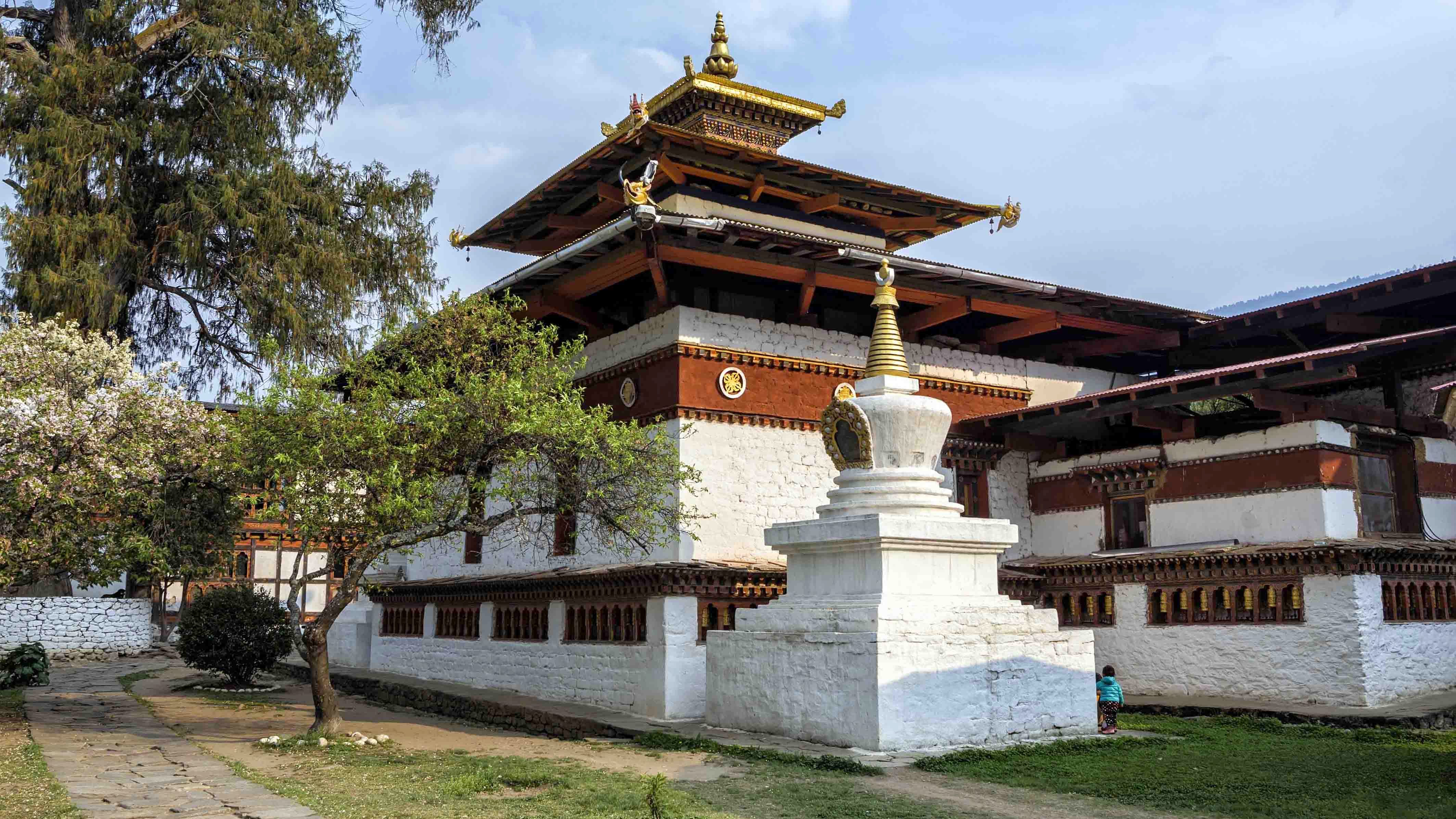
- Historical Background: Kyichu Lhakhang was originally constructed in the 7th century by the Tibetan King Songtsen Gampo. It is said that the king built 108 temples in a single day across the Himalayan region to subdue a demoness that was obstructing the spread of Buddhism. Kyichu Lhakhang is one of the two temples built in Bhutan as part of this legend, with the other being Jambay Lhakhang in Bumthang.
- Architectural Significance: The architecture of Kyichu Lhakhang is a fine example of the classical Bhutanese style, featuring richly adorned exteriors and interiors. The main shrine room houses a large statue of Jowo Sakyamuni, believed to be a replica of the Buddha Sakyamuni who lived in the 6th century B.C. The walls are covered with beautiful paintings and carvings that depict various important Buddhist symbols and teachings.
- Religious and Cultural Importance: Kyichu Lhakhang is considered one of the most holy sites in Bhutan and is a key center of pilgrimage. The temple is believed to have been visited by many famous Buddhist saints, including Guru Padmasambhava in the 8th century, who is said to have concealed many spiritual treasures here. The temple serves not only as a place of worship but also as a hub of cultural preservation, maintaining various religious practices and rituals that are integral to Bhutanese Buddhism.
- Attractions and Features: The temple complex has been expanded and renovated over the centuries and now includes several new structures alongside the original temple. Notable among these is a house that contains a giant statue of Guru Rinpoche. The grounds are also home to a lovely orange tree that miraculously bears fruit all year round, adding to the mystical aura of the place.
- Visiting Kyichu Lhakhang: Visitors to Kyichu Lhakhang can experience a deeply tranquil and spiritual environment. Pilgrims and tourists alike are often found spinning the prayer wheels that line the outer walls of the temple, participating in a practice that is thought to accumulate wisdom and merit.
Tips for Visitors
- Dress Code: As with most religious sites in Bhutan, visitors should dress modestly, covering shoulders and legs.
- Photography: Inside the temple, photography might be restricted to preserve the sanctity of the site.
- Best Time to Visit: Early morning or late afternoon visits can be more peaceful, and the lighting is ideal for experiencing the serene atmosphere of the temple.
Kyichu Lhakhang remains a testament to the spiritual traditions and architectural ingenuity of Bhutan. Its blend of historical significance, religious importance, and architectural beauty makes it a must-visit location for anyone traveling to Paro.
Chele La Pass
Chele La Pass stands as one of Bhutan's highest road-accessible passes, offering a spectacular vantage point over the majestic landscapes of the Himalayas. Located approximately 40 kilometers from Paro and reaching heights of about 3,988 meters (13,083 feet), Chele La connects the valley of Paro to the valley of Haa, providing breathtaking views and a thrilling journey for visitors.
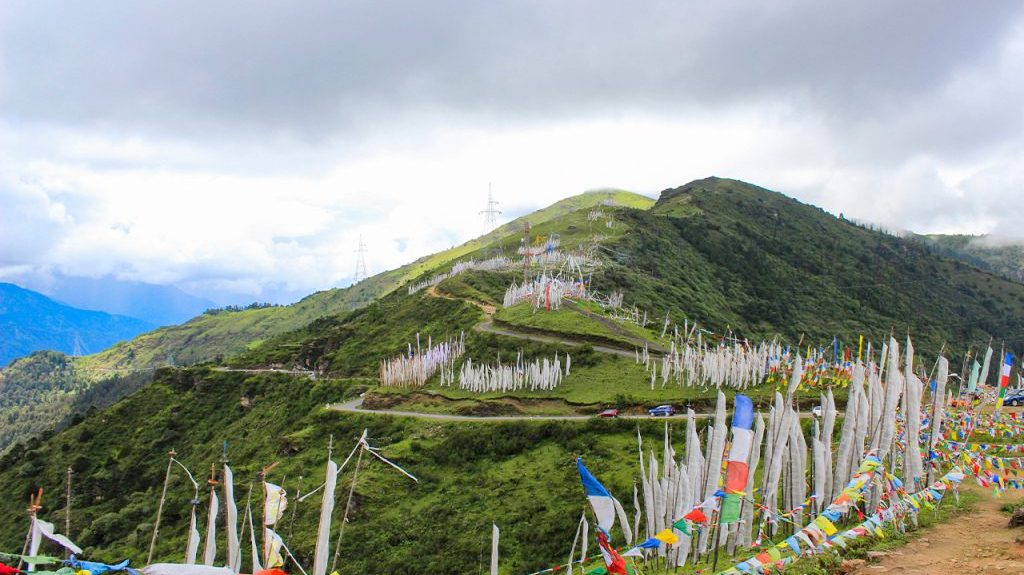
- Geographical Significance: Chele La Pass serves as a strategic point between two significant Bhutanese valleys, Paro and Haa. Due to its high altitude, it offers some of the most stunning panoramic views available in Bhutan, including sights of sacred mountains such as Mount Jomolhari and Jichu Drake. The pass is often covered in a blanket of clouds, and on clear days, it provides a picturesque setting with vibrant prayer flags fluttering against the backdrop of deep blue skies and pristine snow-capped peaks.
- Natural Beauty: The area around Chele La is renowned for its extensive array of flora and fauna. The pass is surrounded by lush forests that are home to diverse species of rhododendrons and other alpine flowers, especially vivid during the spring months. It is also a favored spot for bird watchers, as many of Bhutan's indigenous and migratory birds can be spotted here.
- Recreational Activities: Chele La Pass is not just a place to enjoy passive scenic beauty; it's also a hub for several outdoor activities. Trekking and hiking enthusiasts find the trails around the pass both challenging and rewarding. The pass is also a popular route for cycling adventures, offering a high-altitude road trip experience that is quite unique in the Himalayas.
- Cultural Context: The pass is a significant site for locals, often used for spiritual and ritualistic purposes. The numerous brightly colored prayer flags that adorn the pass are hoisted for blessings, commemorations, and as a means of spreading spiritual peace by the wind that passes through them. The cultural practice of erecting prayer flags reflects the deep Buddhist traditions prevalent throughout Bhutan.
- Visiting Chele La Pass: For those planning a visit to Chele La Pass, it's essential to be prepared for varying weather conditions. The high altitude can lead to rapid weather changes, from sunny and clear to foggy and cold within a short span.
Tips for Visitors
- Clothing: Dress in layers to adapt easily to changing temperatures. Windproof jackets and thermal wear are recommended.
- Travel: The road to Chele La is winding and can be challenging, especially in winter when it might be slippery or snow-covered. It is advisable to visit with a guide or a driver experienced in navigating mountain roads.
- Best Time to Visit: The best months for clear views are from October to February, while those looking to enjoy the blooming rhododendrons should consider visiting in April and May.
Chele La Pass not only offers a journey into nature's splendor but also provides a peek into the spiritual lifestyle of the Bhutanese people, making it a must-visit for anyone traveling to Bhutan, especially those looking to experience the raw and untouched beauty of the Himalayas.
Drukgyel Dzong
Drukgyel Dzong is a historic fortress located in the upper reaches of the Paro Valley in Bhutan. Built in 1649 to commemorate Bhutan’s victory over Tibetan invaders, this once-mighty fortress now stands in picturesque ruins, offering a glimpse into the past and spectacular views of the surrounding landscape, including the sacred mountain, Jomolhari.
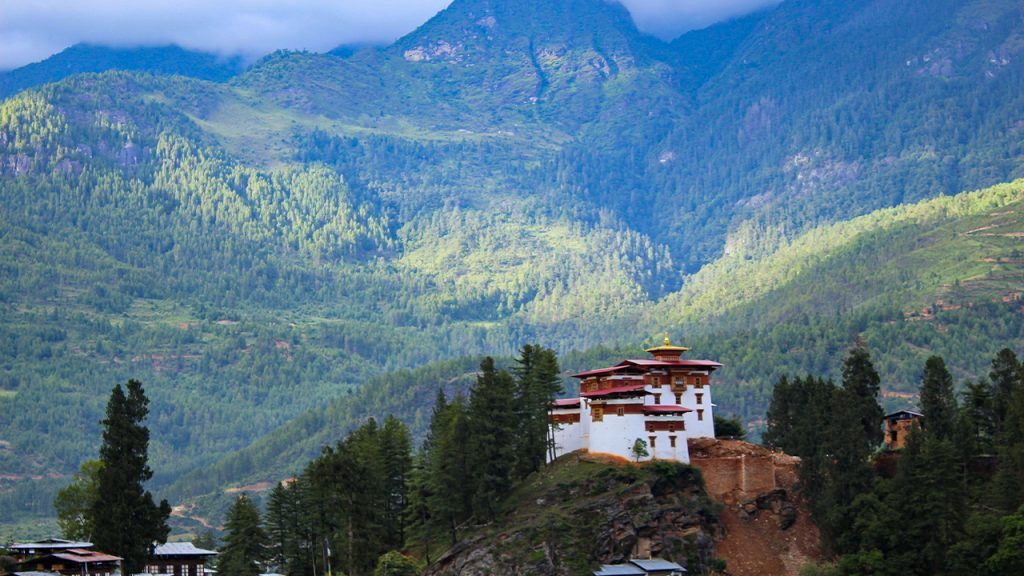
- Historical Significance: The name "Drukgyel Dzong" translates to "The Fortress of Victory," reflecting its foundational purpose as a defense against Tibetan invasions. The dzong was built by Zhabdrung Ngawang Namgyal, the unifier of Bhutan, and played a crucial role in protecting the region. Unfortunately, it was largely destroyed by a fire in 1951, leaving behind the walls and towers that evoke its former grandeur.
- Architectural Features: Although in ruins, the remains of Drukgyel Dzong are impressive and offer insight into the architectural strategies used in Bhutanese fortresses. The dzong's strategic location, on a ridge with a clear view of the valley, exemplifies the military planning of ancient Bhutan. The layout includes a series of courtyards, towers, and defensive walls built using local stone and traditional methods.
- Cultural and Touristic Importance: Drukgyel Dzong is not just an archaeological site but also a cultural icon that symbolizes Bhutanese resilience and strategic military history. The ruins have become a poignant attraction for visitors, who can explore the vestiges of its courtyards and imagine the vibrant life it once housed. The site also serves as a backdrop for the annual Paro Tshechu festival, one of Bhutan's most significant cultural events.
- Natural Setting: The location of Drukgyel Dzong offers some of the most dramatic scenery in Paro. The views of Mt. Jomolhari from the dzong are particularly famous and are considered among the most beautiful in Bhutan. The surrounding area is ideal for trekking, with routes that offer a combination of natural beauty and historical exploration.
- Conservation Efforts: Efforts have been made to stabilize and restore parts of the dzong to ensure its survival as a cultural heritage site. These efforts aim not only to preserve the ruins but also to provide a safer and more informative experience for visitors.
- Visiting Drukgyel Dzong: Visitors to Drukgyel Dzong can walk among the ruins and enjoy the majestic views. It’s a place where history resonates with every step, and the natural beauty of Bhutan is on full display.
Tips for Visitors
- Dress Appropriately: As with all historical and cultural sites in Bhutan, modest dress is advised.
- Photography: Visitors are encouraged to capture the scenic views; however, drone photography might be restricted.
- Accessibility: The terrain can be uneven and requires good walking shoes.
- Best Time to Visit: The best visibility for mountain views typically occurs during the dry season, from October to December.
Exploring Drukgyel Dzong offers a profound journey through time, set against the backdrop of Bhutan's stunning natural beauty. It remains a testament to the architectural prowess and historical significance of Bhutanese culture.
Paro Town
Paro Town is the charming and vibrant heart of the Paro Valley, serving as a central hub for commerce, culture, and tourism in one of Bhutan's most picturesque regions. Nestled at the base of verdant mountains and alongside the meandering Paro Chhu river, this small town blends traditional Bhutanese architecture with the necessities of modern life, creating a welcoming atmosphere for both locals and visitors.
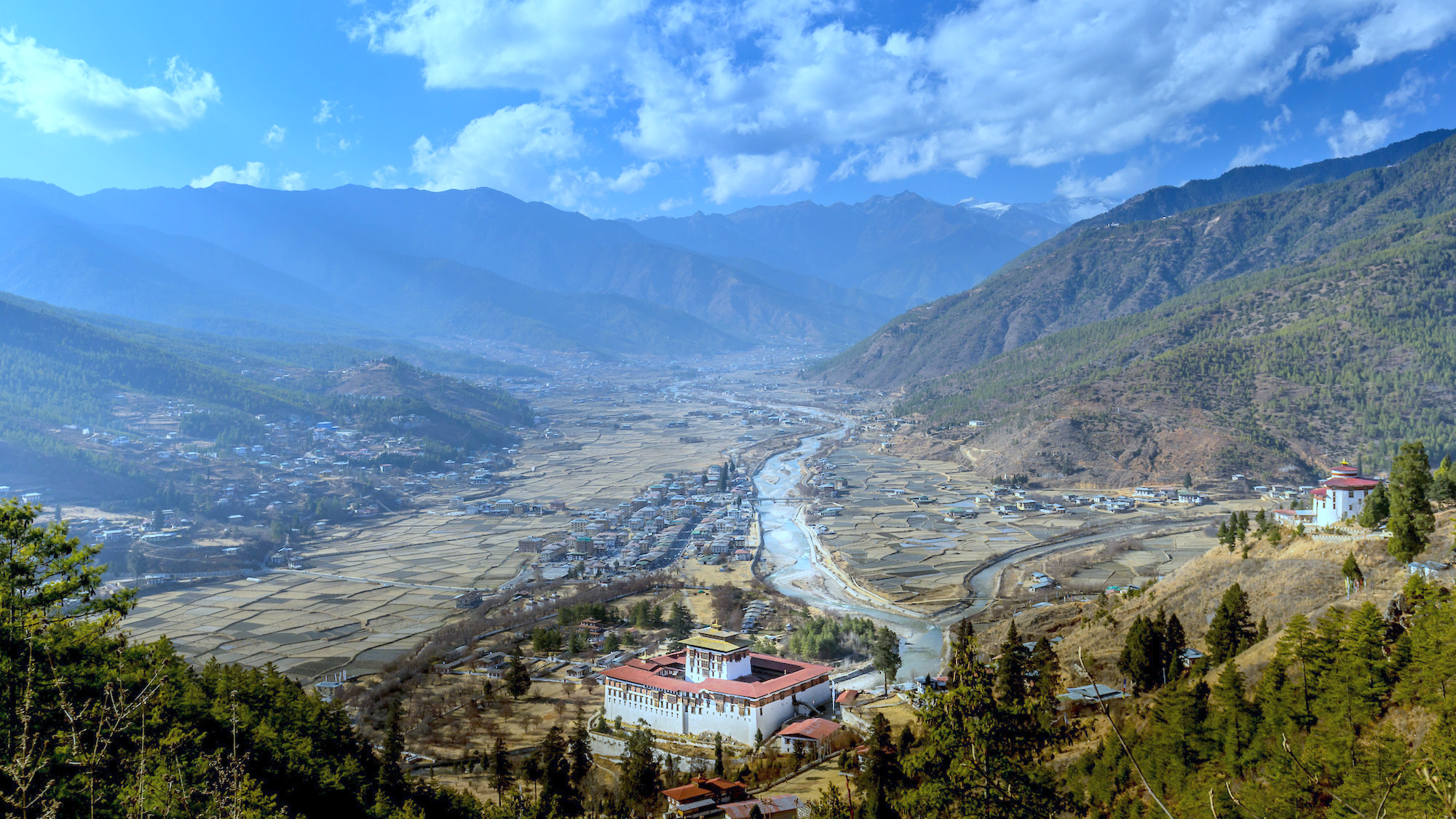
- Cultural and Commercial Center: Paro Town is a focal point for the cultural life of the valley. It boasts many traditional-style buildings adorned with colorful wood carvings and intricate window frames, presenting an authentic Bhutanese aesthetic. The town is compact, making it easy to explore on foot. The main street is lined with shops selling everything from handicrafts and religious items to locally produced food products, offering visitors a taste of Bhutanese craftsmanship and culinary delights.
- Attractions and Activities: One of the main attractions in Paro Town is the weekly market, where local farmers and artisans gather to sell their products. This market is a lively place where visitors can immerse themselves in local life, try traditional Bhutanese foods, and purchase unique souvenirs. Additionally, Paro Town serves as a starting point for various hikes and excursions in the area, including the famous trek to Tiger's Nest Monastery.
- Historical Significance: While Paro is modernizing, it still retains its historical charm and importance. The town area has several important religious and historical sites, including the Paro Rinpung Dzong, a fortress that plays a vital role during the annual Paro Tshechu festival, a colorful display of Bhutanese culture with religious mask dances and ceremonies that attract thousands of visitors and locals.
- Dining and Accommodation: Paro Town offers a range of dining options, from traditional Bhutanese eateries to more international cuisine, catering to the diverse palates of its visitors. The town also hosts a variety of accommodations, from luxurious resorts to cozy guesthouses, ensuring that all travelers can find a comfortable place to stay.
- Natural Beauty: The natural surroundings of Paro Town are breathtaking. The town is set against a backdrop of extensive rice fields, apple orchards, and the historical buildings scattered around the valley. This scenic beauty, combined with the town’s rich culture, makes Paro a memorable destination for any visitor to Bhutan.
Tips for Visitors
- Walking Tours: Consider taking a guided walking tour to learn about the local history and culture.
- Shopping: Visit the local handicraft shops for authentic Bhutanese textiles and handmade products.
- Festivals: If possible, time your visit during the Paro Tshechu to experience Bhutanese culture at its most vibrant.
Paro Town is not just a gateway to the adventures that lie within the Paro Valley but is also a delightful destination in its own right, offering a blend of cultural richness, historical depth, and natural beauty. It's an essential stop for anyone visiting Bhutan, providing a peaceful yet engaging experience of traditional Bhutanese life.
Paro, with its enchanting landscapes and rich cultural heritage, offers a diverse array of must-see attractions that captivate and inspire. From the iconic Tiger's Nest Monastery that hangs dramatically on the cliffside to the serene ambience of Kyichu Lhakhang and the historic ruins of Drukgyel Dzong, each site offers a unique glimpse into Bhutan’s spiritual depth and architectural grandeur. Whether you're trekking through lush valleys, exploring ancient fortresses, or simply soaking in the vibrant atmosphere of Paro Town, the region promises an unforgettable journey filled with awe and wonder. Paro is truly a treasure trove of cultural and natural beauty, making it a perfect destination for those seeking both adventure and contemplation in the heart of Bhutan.
FAQs on Must See Places in Paro
Q: What is the best time to visit Paro?
A: The best time to visit Paro is during the spring (March to May) and autumn (September to November) seasons. During these months, the weather is generally clear and pleasant, making it ideal for trekking and sightseeing.
Q: How difficult is the hike to Tiger's Nest Monastery?
A: The hike to Tiger's Nest Monastery is considered moderate in difficulty. It typically takes about 2 to 3 hours to ascend, depending on your pace. The path is well-maintained but involves a steep climb, so it’s advisable to be in good physical condition.
Q: Are there any entry fees for the historical sites in Paro?
A: Yes, most historical sites in Paro, including Tiger's Nest Monastery and Rinpung Dzong, charge an entry fee. These fees are used for the maintenance and preservation of the sites. It’s best to check the latest fees and regulations before your visit.
Q: What are some must-try foods in Paro?
A: While in Paro, try traditional Bhutanese dishes such as Ema Datshi (chili and cheese), Momos (dumplings), and Red Rice. Local restaurants in Paro Town offer a variety of Bhutanese cuisine that showcases the unique flavors of the region.
Q: Can I take photographs inside the temples and dzongs in Paro?
A: Photography is restricted inside most temples and some areas of the dzongs to preserve the sanctity of the sites. However, you are generally allowed to take photos of the exteriors and the surrounding landscapes. Always check for signs or ask for permission before taking photographs.
Q: What should I wear when visiting religious sites in Paro?
A: When visiting religious sites in Paro, it is important to dress modestly. Cover your arms and legs; wearing long pants and sleeved shirts is recommended. This shows respect for the local culture and religious practices.
Q: How can I reach Paro from the capital city of Thimphu?
A: Paro is approximately a 1-hour drive from Thimphu. You can travel by car or take a local bus. The journey offers scenic views of the mountains and valleys, making it a pleasant road trip.
Q: Is there a guide service available for touring Paro?
A: Yes, there are many reputable guide services available, including those provided by tour operators like Amen Bhutan Tours and Treks. Having a local guide can enrich your visit as they provide valuable insights into the history and culture of the sites.
Q: What are some activities for nature lovers in Paro?
A: Nature lovers can enjoy activities like bird watching, especially at Chele La Pass, or trekking through the beautiful landscapes surrounding Paro, including the Jomolhari Trek which starts near Drukgyel Dzong.
Q: Are there any cultural events I should look out for in Paro?
A: The Paro Tshechu is one of the biggest cultural events in Paro, held annually in the spring. It features mask dances, religious rituals, and vibrant local celebrations, offering visitors a deep dive into Bhutanese culture.
If you are looking for tour packages in Bhutan please click here
If you need any further information, please contact us, Email: at [email protected] , Phone (Whatsapp or Viber) +975-1755-6636
